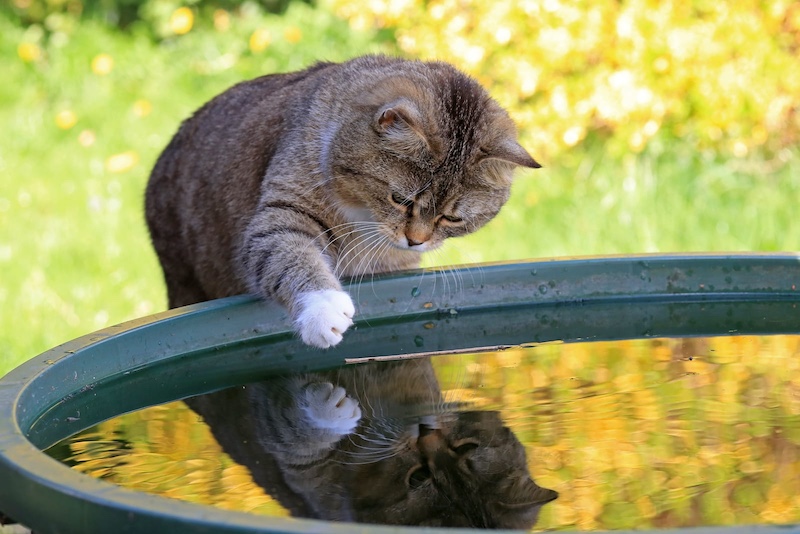Cats can swim instinctively, but not all of them enjoy being in water. While most cats avoid water, some breeds are naturally more comfortable and even playful in it. Understanding these differences helps explain why cats react to water the way they do.
Some breeds, like Turkish Vans and Savannahs, are known for their appreciation of swimming and water play. Knowing which cats are more likely to enjoy water can guide owners in safely introducing their pets to swimming activities if desired.
Can Cats Swim Naturally?
Cats have some basic physical ability to swim, though many factors influence their comfort and skill in water. Their instincts, breed backgrounds, and individual experiences all shape how they respond to swimming.
Instinctive Swimming Abilities
Cats are born with the basic physical ability to swim. Their limb movements and body coordination allow them to paddle and stay afloat if necessary. This instinct is similar to many mammals who can swim from birth.
However, most domestic cats are not natural swimmers by preference. They often tire quickly and dislike being submerged. Their instinct is usually to avoid water, as it can be stressful and unnatural for them.
In survival situations, cats can swim briefly, but they generally do not have endurance or strength for extended swimming. Their fur also retains water, which can weigh them down and cause further fatigue.
Breed Differences in Swimming
Certain cat breeds show more affinity toward water and swimming. For example, the Turkish Van is known as the “swimming cat” because of its unusual tolerance and enjoyment of water.
Breeds with genetic links to wild cats that swim, such as Bengals (descended from Asian leopard cats), may be more confident in water. These cats often exhibit curiosity and less fear of water compared to others.
Most other breeds, especially typical domestic shorthairs or longhairs, are less likely to swim or enjoy water. Breed is a significant factor but does not guarantee a cat will swim comfortably or willingly.
Factors That Affect a Cat’s Willingness to Swim
A cat’s willingness to swim depends on early exposure to water and individual temperament. Cats introduced gradually and positively to water at a young age are more likely to tolerate or even enjoy swimming.
Fear and stress around water are common barriers. Cats that associate water with negative experiences tend to avoid it strictly. Positive reinforcement, patience, and safe supervision can improve acceptance.
Environmental factors such as water temperature, safety, and the presence of humans also influence willingness. Cold or deep water generally discourages cats, while calm, shallow environments are less intimidating.
Safety Considerations for Swimming Cats
Cats face specific dangers around water that must be managed carefully. Proper supervision and the ability to recognize distress signals are essential to keep cats safe near pools or other bodies of water.
Water Hazards and Risks
Cats can swim, but water can be hazardous. Pool covers may trap cats underwater if they cannot find an exit. Chemicals commonly used in pools, such as chlorine, can irritate a cat’s skin or eyes and be harmful if ingested.
Sharp pool edges and slippery surfaces increase the risk of injury. Depth is another concern; cats can tire quickly, especially in deep water. Ensure there are multiple easy exit points, such as ramps or steps, to help cats leave the water safely.
Supervision and Guidance
Cats should never be left alone near water. Even strong swimmers can become fatigued or disoriented and require immediate help.
Introducing a cat to water should be gradual and always under close watch. Using a cat-specific life jacket adds safety, especially for beginners or cats unfamiliar with swimming. Installing pool alarms or fencing can prevent accidental, unsupervised access to the pool area.
Recognizing Signs of Distress
Cats in distress may struggle to keep their heads above water, exhibit frantic pawing, or vocalize loudly. Unusual restlessness or attempts to escape the water quickly also indicate trouble.
Physical signs include trembling, excessive drooling, or difficulty breathing after being in the water. Prompt removal from water and drying off is critical. Observing behavior closely before, during, and after water exposure helps prevent accidents.
How to Introduce a Cat to Water
Introducing a cat to water requires patience, careful observation, and controlled conditions. The process usually involves slowly building the cat’s comfort level, rewarding positive interactions, and selecting a safe environment that minimizes stress.
Gradual Acclimation Techniques
Start by exposing the cat to shallow, calm water, such as a partially filled bathtub or a kiddie pool. Let the cat explore at its own pace without forcing it in the water. Slowly increase the water depth over multiple sessions.
Use a gentle approach by wetting the cat’s paws first. If the cat remains calm, gradually splash a small amount of water on its fur. Avoid sudden movements to prevent startling the cat.
Limit each introduction to just a few minutes until the cat shows signs of relaxation. This slow and steady exposure helps the cat build positive associations with water without triggering fear or anxiety.
Positive Reinforcement Methods
Reward the cat immediately after any calm or curious behavior around water. Use treats, praise, or petting to create positive links with the water experience.
Avoid punishment or pushing the cat into the water, as this can increase resistance and fear. Instead, stay patient and reward small steps, like touching the water or stepping closer.
Consistency is key. Regular sessions, even short ones, reinforce learning. Positive reinforcement helps the cat feel safe and confident during water exposure over time.
Choosing the Right Environment
Select a quiet, warm, and secure location for water introductions. A familiar space, like a bathroom or enclosed yard, can reduce external stressors.
Water temperature should be lukewarm to prevent distress. Avoid strong currents, waves, or deep water initially, which can overwhelm the cat.
Ensure the area is slip-resistant and escape routes are available. Supervise every moment to maintain safety and control during the introduction phase.
Benefits and Drawbacks of Cats Swimming
Swimming can have important effects on a cat’s physical health, mental state, and grooming needs. Understanding these impacts helps determine when swimming is beneficial or potentially problematic for cats.
Potential Health Benefits
Swimming offers cats a low-impact form of exercise that supports muscle building and joint health without putting strain on bones. It can be especially helpful for overweight cats or those with arthritis, as the water’s buoyancy reduces pressure on joints.
Regular swimming also helps maintain a healthy weight, reducing risks associated with obesity. The resistance of water provides muscle toning and cardiovascular improvements absent in some cats’ usual activity routines.
However, swimming is not suitable for every cat. Individual health, age, and temperament influence how beneficial swimming may be. Proper supervision and safety measures are essential to avoid exhaustion or injury.
Stress and Anxiety Factors
Swimming can affect a cat’s stress levels in different ways. For cats familiar with water or specific breeds that enjoy swimming, it may serve as a rewarding physical activity that relieves tension.
Conversely, many cats find water stressful or frightening. For these cats, forced exposure to swimming can increase anxiety and negatively impact their well-being. Gradual introduction and respecting a cat’s preferences are crucial.
Owners should observe their cat’s behavior closely around water and avoid pushing reluctant cats. When done correctly, swimming can offer mental stimulation and stress relief, but it is not universally calming for all cats.
Impact on Grooming and Fur
Exposure to water changes the grooming needs of cats as their fur becomes wet, heavier, and more prone to matting. Long-haired breeds especially require thorough drying to prevent discomfort and skin problems.
Wet fur can impact a cat’s natural insulation, making it more vulnerable to cold if not dried properly. This can lead to health risks in cooler environments.
Additionally, cats often lick their fur excessively to dry themselves after swimming, which can stress their digestive system when excess fur is ingested. Careful grooming and drying after swimming sessions reduce these risks.
Famous Swimming Cats and Real-Life Examples
Certain cat breeds have a natural affinity for water due to their fur type and environment. Additionally, some individual cats show a genuine enjoyment of swimming. Instances of water-loving cats have also gained attention online and in media.
Notable Cat Breeds Known for Swimming
The Turkish Van is a breed famously associated with swimming. Originating from Eastern Turkey, this cat has a unique water-resistant coat that helps it stay buoyant. The breed often swims in lakes and rivers, using its strong legs to paddle effectively.
The Maine Coon is another breed known for its fondness of water. Its dense, long fur does not absorb water easily, and many Maine Coons enjoy playing near water or dipping their paws.
Other breeds, like the Bengal and Siberian, also display swimming abilities or tolerance to water. Their muscular build and instinctive paddling skills make them capable swimmers when necessary.
Stories of Cats Who Enjoy Water
Some domestic cats surprise their owners by willingly entering pools, bathtubs, or even rain puddles. One cat gained attention for regularly swimming in a home pool, demonstrating controlled, confident strokes.
In the wild, fishing cats are exceptional swimmers that hunt fish underwater. These cats have sleek fur that repels water and allow them to dive for prey with precision.
Occasionally, videos surface of cats playing in water, paddling, or even diving to retrieve toys. These examples showcase how individual temperament and early exposure can influence a cat’s comfort with swimming.
Media and Internet Sensations
Online platforms have amplified stories of water-loving cats, turning several into internet sensations. Videos of swimming cats, especially those displaying playful behavior in pools or lakes, attract millions of views.
Some cats have become recurring stars in pet media for their unexpected comfort with water. Their owners often share tips on gradually introducing cats to water to prevent stress.
These online examples have shifted perceptions about cats and swimming, revealing that some felines can not only swim but enjoy it as part of their lifestyle.

